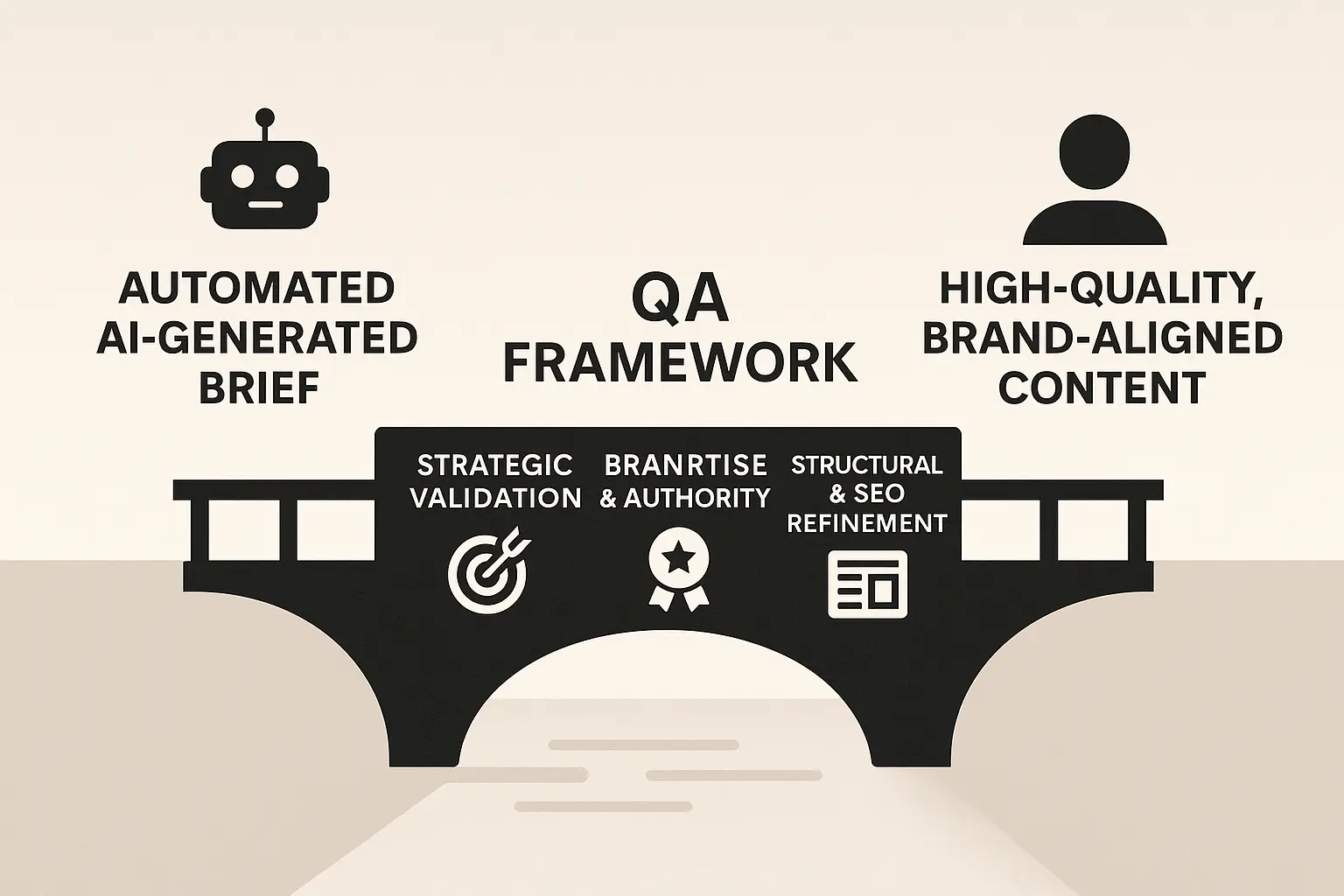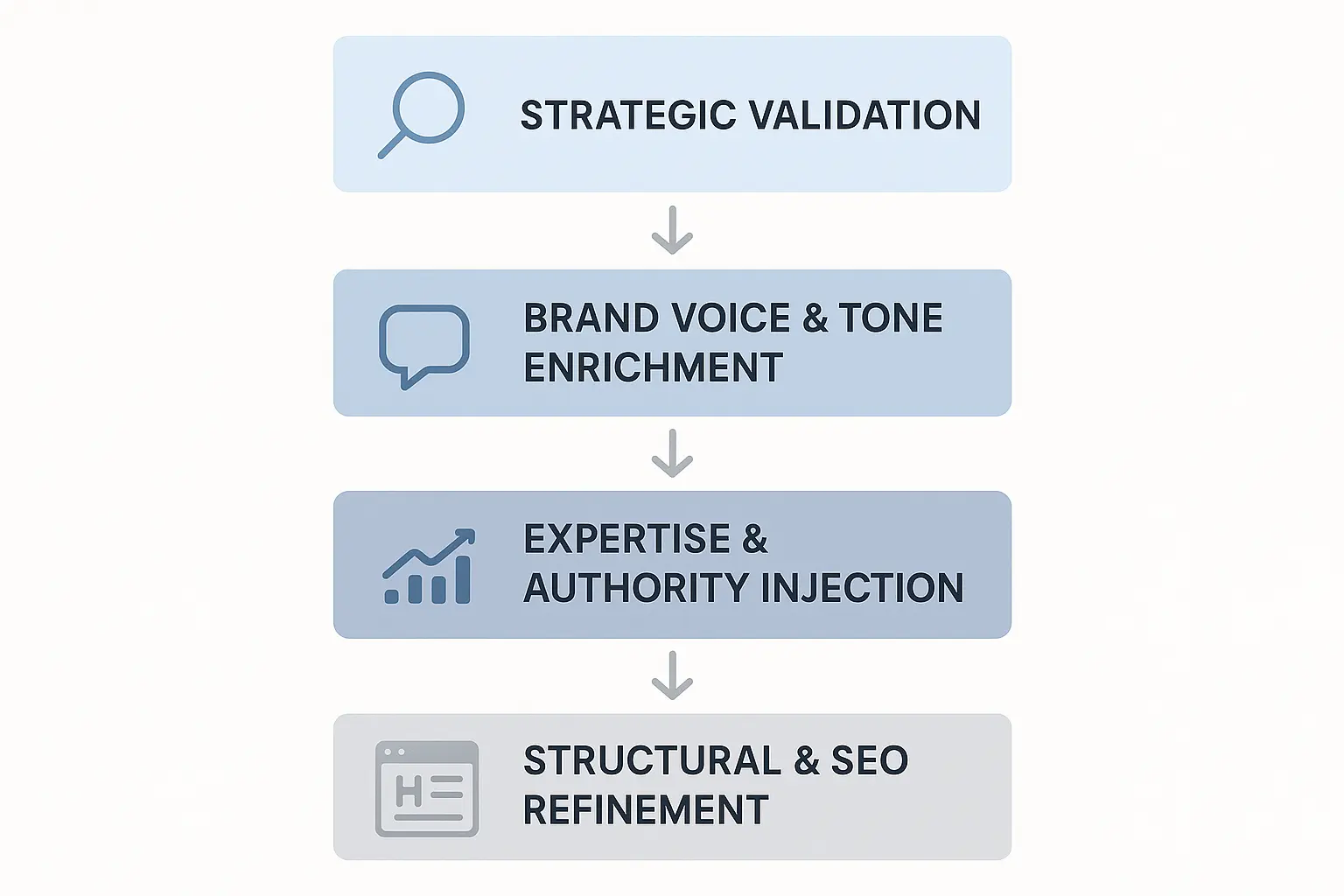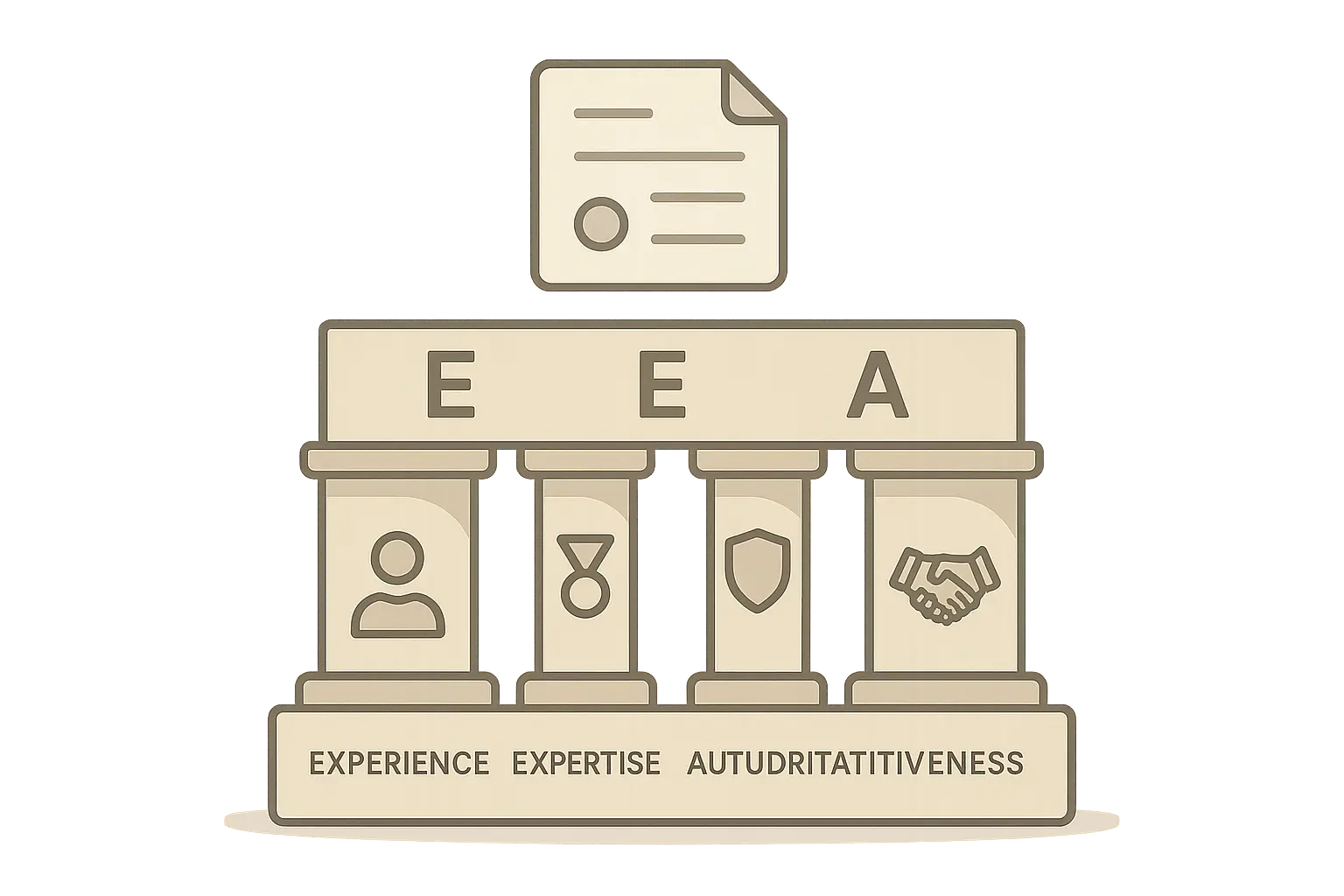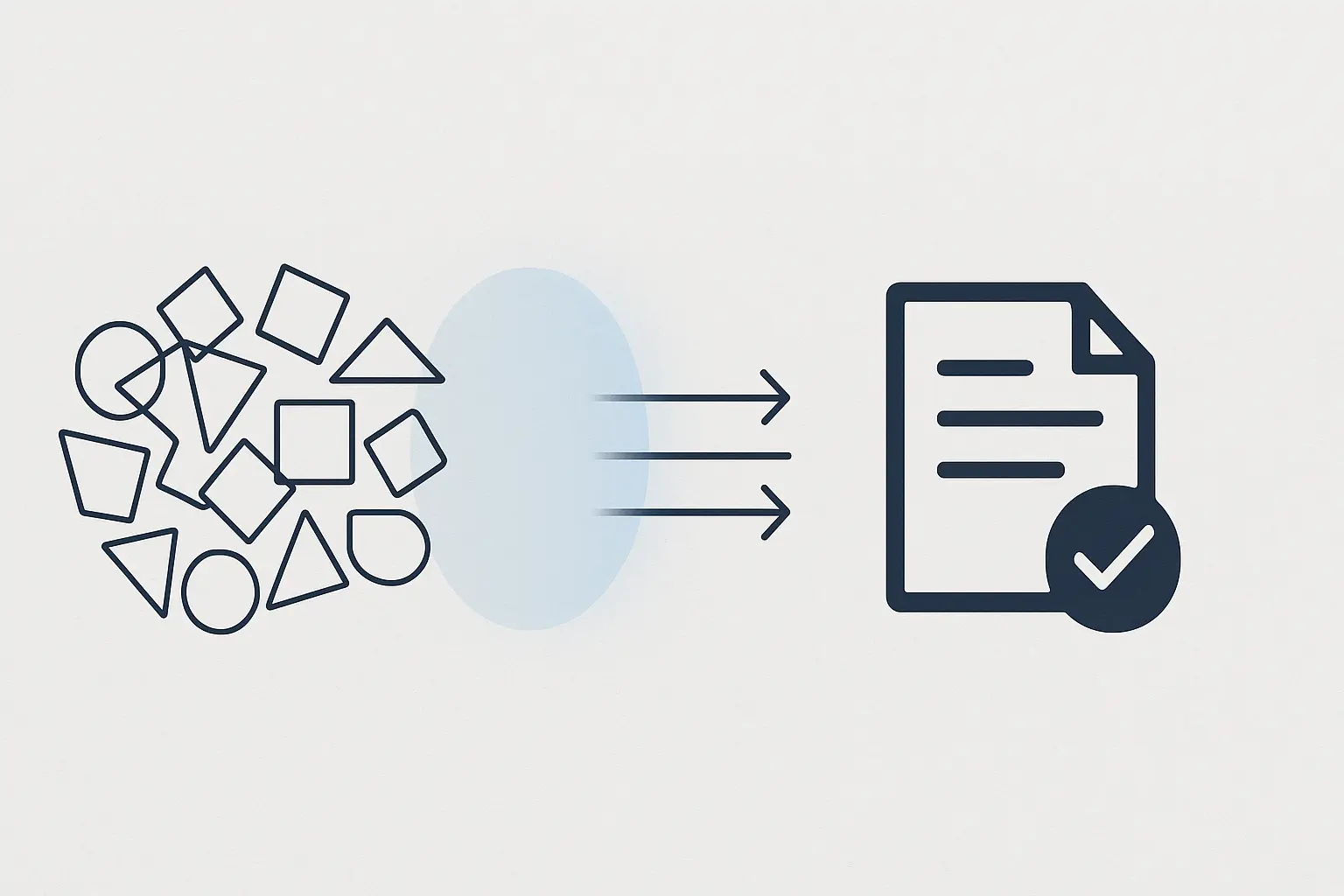You’ve done it. You found the perfect AI tool, fed it a target keyword, and in 90 seconds, it produced a beautiful, comprehensive content brief. It has keywords, competitor headlines, and word count targets—everything looks ready to go. You forward it to your writer, feeling the thrill of efficiency.
A week later, the draft comes back. It’s… fine. It ticks all the boxes in the brief, but it has no soul. Instead of a compelling argument, it’s a collection of facts. It reads less like advice from a trusted expert and more like a summary of the internet.
If this scenario feels familiar, you’re not alone. With over 64% of marketers now using AI for content creation, the dream of instant, high-quality content is meeting a complex reality. The tool is doing its job, but something crucial is getting lost in translation. The problem isn’t the AI; it’s the absence of a human-led quality assurance (QA) framework.
Why “Good Enough” AI Briefs Lead to Mediocre Content
AI is brilliant at analysis and aggregation. It can scrape the SERPs, identify common themes, and structure a logical outline faster than any human. But its primary goal is to find patterns in existing data. It creates a “mean” of what’s already ranking—which is, by definition, average.
This leads to a few critical gaps:
-
The Nuance Gap: AI struggles with the subtle why behind a search query. It understands the words but can miss the user’s underlying emotion, context, or ultimate goal.
-
The Brand Gap: An AI brief knows nothing about your client’s unique voice, their proprietary data, or the hard-won perspective that makes them an authority.
-
The Trust Gap: It can’t replicate the signals of genuine experience and expertise that Google’s E-E-A-T (Experience, Expertise, Authoritativeness, Trustworthiness) guidelines reward.
It’s no surprise, then, that nearly 43% of marketers cite “producing quality content” as their biggest challenge with AI, and over 38% worry about factual accuracy and the “hallucinations” that can creep into purely automated outputs. Relying on a raw AI brief is like asking an architect to design a house based only on the square footage of other houses on the block. You’ll get a structure, but you won’t get a home.
The Strategist’s Role in an AI-First World: From Creator to Curator
Here’s the good news: this doesn’t mean AI tools are useless. Far from it. They are incredibly powerful co-pilots. They free you from manual, time-consuming data gathering so you can focus on what truly matters: strategy.
Your role is shifting from creator of the brief to its curator and enhancer. You act as the human filter, transforming an automated output into a strategic directive. Your job is to infuse the AI’s data-driven skeleton with the human elements of voice, insight, and intent.

That’s where a QA framework comes in. It’s a simple, repeatable checklist that ensures every AI-assisted brief gets the strategic oversight needed to produce exceptional content.
The 5-Step QA Checklist for Flawless AI Content Briefs
Apply this checklist to the next brief that comes out of your AI tool. This 15-minute process can be the difference between content that merely exists and content that performs.
1. Validate Core Intent and Audience Alignment
Before you look at a single keyword, ask: Did the AI get the real reason for the search? A query like “best project management software” could be for a solo freelancer or a 500-person enterprise. The content needed for each is wildly different.
-
Your Action: Open an incognito window and perform the search yourself. What kind of results do you see? Are they listicles, in-depth reviews, or landing pages? Who are they speaking to? The SERP is the ultimate source of truth for intent.
-
The Goal: Add a one-sentence “Primary User Goal” at the top of the brief to anchor the writer. Example: “The reader is a marketing manager at a small agency looking for a simple, affordable tool to manage 5-10 client projects.”
2. Inject Your Brand’s Unique Voice and Perspective
This is where you move from commodity content to a branded asset. An AI can’t know your client’s witty tone, their preference for certain analogies, or their passionate stance on an industry topic.
-
Your Action: Add a “Brand Voice & Tone” section to the brief. Be specific. Instead of “be professional,” write “Write like a knowledgeable mentor explaining a complex topic over coffee. Use simple language, short paragraphs, and ask rhetorical questions to engage the reader.”
-
The Goal: Give the writer the tools to sound like your client, not like the AI. For a deeper dive, learn more about our approach to omnichannel growth SEO, which connects brand voice across all digital touchpoints.
3. Layer in Proprietary Data and Human Experience
This is your moat—the one thing your competitors (and their AI) cannot replicate. AI briefs are built on public information; your job is to enrich them with private, unique value.
-
Your Action: Create a dedicated section in the brief called “The Human Touch / Proprietary Insights.” Prompt the writer to include specific elements. This could be:
- A quote from the company’s founder.
- An anonymized data point from a client case study.
- A personal anecdote that illustrates a key point.
- A link to an internal whitepaper or dataset.
-
The Goal: Create content that is truly original and defensible. This builds authority and provides value that can’t be scraped from other websites.

4. Refine for E-E-A-T Signals
Google wants to rank content from real experts. An AI-generated outline often lacks the specific markers of credibility that build trust with both users and search engines.
-
Your Action: Review the outline and add explicit prompts to build authority. For example:
- “Cite the recent Gartner report on this topic.”
- “Embed the YouTube video from our lead engineer explaining this process.”
- “Link out to these three specific university studies.”
- “Make sure the author’s bio is included at the end.”
-
The Goal: Deliberately bake trust signals into the content, which directly addresses marketer concerns about AI’s accuracy and quality.
5. Ensure the Brief is a Guide, Not a Cage
The most common mistake is creating a brief so rigid it turns a talented writer into a robot. A great brief provides guardrails and inspiration, not a paint-by-numbers prison.
-
Your Action: Phrase suggestions as questions. Instead of “Write 300 words on Topic X,” try “Can we explore the common misconception around Topic X here? What’s a compelling way to debunk it?”
-
The Goal: Empower your writer to use their creativity and expertise. You hired them for their brain, not just their ability to follow instructions. A great brief sparks their best work.
Putting It All Together: From Automated Draft to Strategic Deliverable
By running every AI-generated brief through this 5-step QA process, you transform it from a simple data dump into a strategic asset. You get the speed of automation, layered with the nuance, brand voice, and authority that only a human expert can provide.
This process is central to how we deliver white-label SEO execution, blending automation with deep strategic oversight to create content that doesn’t just rank, but resonates.

Frequently Asked Questions (FAQ)
How long should this QA process take?
Once you’re practiced, this checklist shouldn’t take more than 15-20 minutes per brief. It’s a small investment of time that prevents hours of frustrating rewrites and dramatically improves the final asset’s performance.
Can’t I just prompt the AI to include our brand voice?
You can, and it’s a good starting point. However, AI tends to produce a shallow imitation of a voice. It can mimic tone but can’t invent unique perspectives or share genuine experiences. The “Proprietary Insights” step, in particular, requires human intervention.
Is my AI tool bad if I have to do all this?
Not at all! Think of your AI tool as a brilliant but very junior researcher. It does the legwork of gathering and organizing all the publicly available information. Your role as the senior strategist is to review that research, add your expertise, and set the final direction.
Does this process slow down content velocity?
Initially, it might feel like an extra step. However, it drastically reduces the number of revision cycles needed. A clear, strategically-sound brief leads to a better first draft, saving you and your writer significant time on the back end and getting high-quality content published faster.
Your Next Step: From Learning to Leading
AI isn’t a threat to the strategic SEO; it’s the ultimate force multiplier. By embracing your role as a curator and quality controller, you elevate your value and deliver results that no standalone algorithm can achieve.
Take this 5-step checklist and apply it to your very next content brief. See how it transforms the conversation with your writer and, ultimately, the quality of the final product.
As agencies look to grow, many are exploring how an SEO enablement model can help them scale this strategic work across dozens of clients without a proportional increase in headcount. The future isn’t about choosing between humans and AI; it’s about creating systems where they work together, seamlessly.

